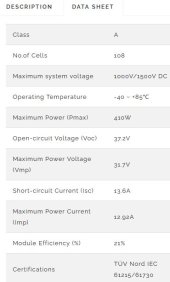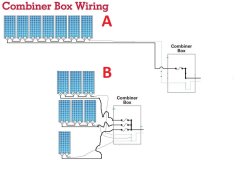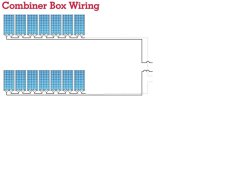You are using an out of date browser. It may not display this or other websites correctly.
You should upgrade or use an alternative browser.
You should upgrade or use an alternative browser.
Is A the same as B ?
- Thread starter rd400f
- Start date
Doggydogworld
Solar Enthusiast
- Joined
- Aug 29, 2022
- Messages
- 362
No, the lines in A are much neater and straighter 
A has 7 panels in series. B has 3 panels in series in parallel with another 3 panels in series in parallel with a single panel.
If Vmp is 30V then A is a single 210V string. B is trying to parallel two 90V strings with a 30V panel. That's...... sub-optimal. If you drop the single panel you'll have a 3S2P array that operates around 90V (or whatever 3x your single panel Vmp is).
A has 7 panels in series. B has 3 panels in series in parallel with another 3 panels in series in parallel with a single panel.
If Vmp is 30V then A is a single 210V string. B is trying to parallel two 90V strings with a 30V panel. That's...... sub-optimal. If you drop the single panel you'll have a 3S2P array that operates around 90V (or whatever 3x your single panel Vmp is).
sunshine_eggo
Happy Breffast!
No, the lines in A are much neater and straighter
A has 7 panels in series. B has 3 panels in series in parallel with another 3 panels in series in parallel with a single panel.
If Vmp is 30V then A is a single 210V string. B is trying to parallel two 90V strings with a 30V panel. That's...... sub-optimal. If you drop the single panel you'll have a 3S2P array that operates around 90V (or whatever 3x your single panel Vmp is).
LOL... dramatic understatement.
In so extreme a voltage disparity, it is unlikely the array will output anything at all as the two 90V strings are essentially shorted through the 30V panel.
Rednecktek
Solar Wizard
No, Box A is a 7s string and Box B is a nerfed 3s2p setup getting murdered by a panel.
To explain that further let's say you've got 7 of the Generik 100w solar panels each producing 5a @ 20v:
Setup A gives you (7 * 20v =) 140v @ 5a = 700w
Setup B without the lone panel gives you (3*20v =) 60v @ (2x 5a=) 10a = 600w
Setup B with the oddball panel drops everything down to the lowest common denominator, which would be the single 20v panel which would give you 20v @ (3 * 5a =) 15a = 300w, or less than half your array's potential. That's assuming the panels don't just blow their fuses as soon as the sun comes up, which they most likely would.
Plus, if you wired everything up according to Setup B, we would mock you for the ugly rats nest of cables in all those squiggles. ?
To explain that further let's say you've got 7 of the Generik 100w solar panels each producing 5a @ 20v:
Setup A gives you (7 * 20v =) 140v @ 5a = 700w
Setup B without the lone panel gives you (3*20v =) 60v @ (2x 5a=) 10a = 600w
Setup B with the oddball panel drops everything down to the lowest common denominator, which would be the single 20v panel which would give you 20v @ (3 * 5a =) 15a = 300w, or less than half your array's potential. That's assuming the panels don't just blow their fuses as soon as the sun comes up, which they most likely would.
Plus, if you wired everything up according to Setup B, we would mock you for the ugly rats nest of cables in all those squiggles. ?
Hedges
I See Electromagnetic Fields!
- Joined
- Mar 28, 2020
- Messages
- 21,111
When (or if) fuse on single panel blows, B becomes 3s2p. Then it may work.
What are your panel and inverter (or SCC) specs?
I resemble that remark!
What are your panel and inverter (or SCC) specs?
Plus, if you wired everything up according to Setup B, we would mock you for the ugly rats nest of cables in all those squiggles. ?
I resemble that remark!
sunshine_eggo
Happy Breffast!
Provided your Voc does not exceed MPPT limits and allows margin for low temperatures.
42OhmsPA
What's in a title?
Go to suncalc.org and see if you'll get shading then go to pv watts. gov and see what you'll produce on average.Hi
So if the 2 strings of 7 panels each is ok.
What could you do if you think you will end up with ...lets say the lh end of the strings getting progressively shaded thru out the day.?
Thanks
Richard
View attachment 162132
Ps Thank you so much for not making this about a vs b battery cells, that's what I thought when I read the title. ?
Pss don't use the B configuration, it Bad.
sunshine_eggo
Happy Breffast!
Hi
So if the 2 strings of 7 panels each is ok.
What could you do if you think you will end up with ...lets say the lh end of the strings getting progressively shaded thru out the day.?
In order of preference:
- cut down the offending shader
- relocate your panels
- Install Tigo optimizers on shaded
Hedges
I See Electromagnetic Fields!
- Joined
- Mar 28, 2020
- Messages
- 21,111
Hi
Yes using Paint with a shaky hand...what can I say.
So lets say we have 2 strings of 7 panels each.
Each string going in to a separate MPP Tracker.
You guys happy with this setup?
Need to know panel and MPPT specs, to see if voltage is OK.
Hi
So if the 2 strings of 7 panels each is ok.
What could you do if you think you will end up with ...lets say the lh end of the strings getting progressively shaded thru out the day.?
Thanks
Richard
If progressive shading can't be avoided, it is ideal to have both strings similarly shaded.
Most panels have 3 diode-bypassed sections left, middle, right. So the orientation you show would be ideal, shading one section at a time (rather than end of all three sections at once.)
Consider where shade comes from and horizon and strongest sun at noon (and any fog) to come up with best tilt and orientation. Also consider different orientations for each string.
HiNeed to know panel and MPPT specs, to see if voltage is OK.
If progressive shading can't be avoided, it is ideal to have both strings similarly shaded.
Most panels have 3 diode-bypassed sections left, middle, right. So the orientation you show would be ideal, shading one section at a time (rather than end of all three sections at once.)
Consider where shade comes from and horizon and strongest sun at noon (and any fog) to come up with best tilt and orientation. Also consider different orientations for each string.
Inverter and panels specs.


So knowing the spec of the inverter and the panels would there be any other panel layout that would handle shading starting from LH to RH?
Thanks
Richard
Rednecktek
Solar Wizard
Factoring in 20% paranoia for cold factor, a 7s string would max out at 312v so well under your limit. In perfect conditions you could theoretically get 5740w out of the array so if you wanted to ball-park a 70% efficiency over the day at 4 hours that would be 5740w * .7eff * 4hr = about 16Kwh generated per day, or about 3 rack mount batteries fully charged plus system overhead... roughly. It depends on the shading and temperature but as a wild-ass-guess that seems reasonable with light shading. The only way to be sure is to actually build the system and check out the logs after a while to see how much your shading and weather affect it.
Hedges
I See Electromagnetic Fields!
- Joined
- Mar 28, 2020
- Messages
- 21,111
37.2 Voc x 7s = 260.4V
Max allowed 500V, so could have longer strings.
410W (STC) x 7 = 2870 per input.
8000W max (recommended) array power, so could have more panels.
2 MPPT, no combiner box needed, just one string per MPPT. Then it doesn't matter if one is more heavily shaded than the other.
12.92A Imp, 16A max per MPPT, can't parallel two strings without clipping unless very steep angle relative to each other.
Fine like it is. You can add several panels in series if desired. Definitely up to 11s, possibly 12s if we get temperature related parameters to check.
Max allowed 500V, so could have longer strings.
410W (STC) x 7 = 2870 per input.
8000W max (recommended) array power, so could have more panels.
2 MPPT, no combiner box needed, just one string per MPPT. Then it doesn't matter if one is more heavily shaded than the other.
12.92A Imp, 16A max per MPPT, can't parallel two strings without clipping unless very steep angle relative to each other.
Fine like it is. You can add several panels in series if desired. Definitely up to 11s, possibly 12s if we get temperature related parameters to check.
Hedges
I See Electromagnetic Fields!
- Joined
- Mar 28, 2020
- Messages
- 21,111
Distance almost never matters for PV panels and size of wires.
If you said 100 meters I might check the math, but voltage drop would still only be a couple percent at peak current, since your array is hundreds of volts. You can look up resistance and check the math just for educational purposes. It matters for battery cables and AC wiring.
Check ampacity tables. Wires, and breakers/fuses if needed, should be at least 1.56x PV panel short circuit current Isc.
If 2 or 3 string, 4 or 6 current carrying conductors in a conduit, then derate wire to 80% of ampacity given in the tables.
13.6A Isc - looks to me like 12 awg is a little too small according to the calculation, but I wouldn't worry about it if it wasn't an inspected installation; the ampacity is sufficient even with multiple strings wired in conduit, but we're not supposed to go higher than 20A. 10 awg would be to code. Do the exercise, see what numbers you come up with.
Run a ground wire too, from inverter chassis to PV frame chassis. That prevents AC shocks a number of people have reported.
If you said 100 meters I might check the math, but voltage drop would still only be a couple percent at peak current, since your array is hundreds of volts. You can look up resistance and check the math just for educational purposes. It matters for battery cables and AC wiring.
Check ampacity tables. Wires, and breakers/fuses if needed, should be at least 1.56x PV panel short circuit current Isc.
If 2 or 3 string, 4 or 6 current carrying conductors in a conduit, then derate wire to 80% of ampacity given in the tables.
13.6A Isc - looks to me like 12 awg is a little too small according to the calculation, but I wouldn't worry about it if it wasn't an inspected installation; the ampacity is sufficient even with multiple strings wired in conduit, but we're not supposed to go higher than 20A. 10 awg would be to code. Do the exercise, see what numbers you come up with.
Run a ground wire too, from inverter chassis to PV frame chassis. That prevents AC shocks a number of people have reported.
Similar threads
- Replies
- 1
- Views
- 158
- Replies
- 2
- Views
- 408
- Replies
- 5
- Views
- 446





